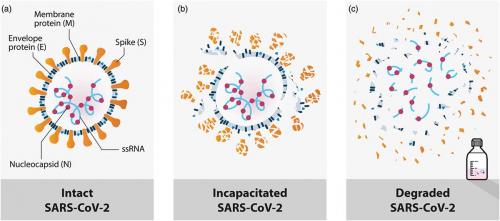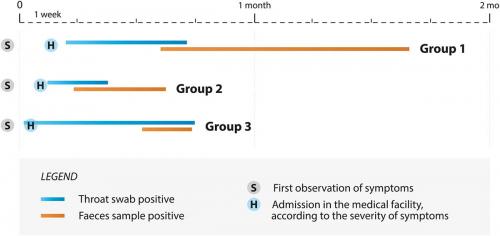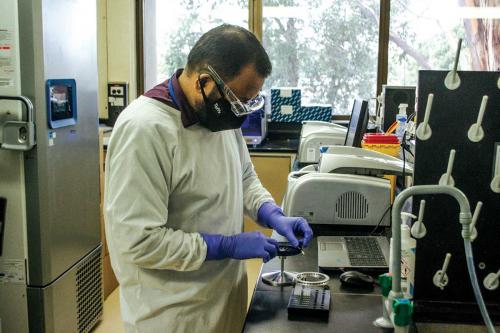Since early last year, every one of us has benefited in some way from researchers’ achievements in relation to vaccine development, diagnostic tests, test kits, hand sanitisers, masks, treatments and more. But few of us will be aware of the achievements of ColoSSoS: Collaboration on Sewage Surveillance of SARS-CoV-2.
Led by Water Research Australia (WaterRA), the ColoSSoS project brings together a broad community of research organisations, water authorities and state health departments. It involves national experts in health, microbiology, laboratory testing, wastewater-based epidemiology and policy communication, and links to global expertise through the Australian Water Association, Global Water Research Coalition and the US Water Research Foundation.
It has been known for roughly 75 years that sewage wastewater can be used to provide critical signals about infection rates in populations. This has been demonstrated for several enteric viruses such as norovirus, hepatitis A virus and poliovirus.
‘The ColoSSoS Project leverages the 20+ years of health and water-based research undertaken by WaterRA and its predecessor – the CRC for Water Quality and Treatment’, says ColoSSoS project director Dr Kelly Hill.
As far back as 1996, research was shared among WaterRA members through their publication Health Stream, covering the topic of water, waste and wellbeing. A project funded by the Cooperative Research Centre for Water Quality and Treatment aimed to investigate and document a variety of existing surveillance systems relating to the detection of gastrointestinal disease in the community and assess the feasibility of linking these with water quality data. Such information assistance is similar to what is currently being used in the ColoSSoS project to support the national pandemic response.
While diagnostic testing can detect infection in individuals, wastewater-based epidemiology can provide a great deal of information for public health experts on communities, the prevalence of viruses, trends, and the occurrence of otherwise undetected infection. It can provide a particularly effective early warning of disease outbreaks.
For example, an outbreak of a wild poliovirus type 1 was detected during surveillance of the sewerage system in Israel in February 2013. At this point, no cases of acute infection had been detected, yet an emergency immunisation drive was initiated, in which more than one million children under nine were re-vaccinated. Reports estimate that although up to 60% of susceptible individuals became infected within six months, not one child was left paralysed because of the outbreak (bit.ly/3eZqKOz).
The first cases of COVID-19 in Australia were identified in late January 2020. By March, numbers had spiked to several hundred cases a day. The ColoSSoS initiative was established that same month to rapidly develop an effective analytical tool for detecting SARS-CoV-2 fragments in wastewater, building upon the systems already in place at wastewater treatment plants.
‘The ColoSSoS program is a global first for leading the sewage surveillance initiative in close collaboration with health departments. This program is one-of-a-kind as it is driven and informed by jurisdictional health departments every step of the way’, says Hill.
What makes ColoSSoS so interesting – and so successful – is the principles on which it was founded: that all participants must ‘adopt the collaborative framework, conduct all research and activities in a direct response to end-user needs to support public health decision making, to openly share ideas and thoughts, and openly share learnings, work conducted in this program will not be used for commercial gain, or unduly delayed in the pursuit of publication’ (bit.ly/3y8koTQ).
From the outset, Hill and her colleagues adopted a four-step expert working group approach: developing a sound sampling strategy, laboratory testing, interpretation and epidemiology, and communication. She directly attributes the success of the initiative to the experts who formed each of the working groups – national and international experts across water utilities, research, consultancies and, most importantly, the health agencies.
Coronaviruses (named for their round appearance and spiked surfaces) are a very large and diverse family of ‘enveloped RNA’ viruses. Unlike ‘naked’ viruses, they have a lipid envelope around the surface of the virus, the structure of which holds the membrane, envelope and spike proteins together. This actually makes them more fragile than other viruses, because the virus loses its ability to infect human host cells if the lipid envelope is destroyed.
Like other coronaviruses, SARS-CoV-2 is sensitive to ultraviolet light and chlorine disinfection, and is rapidly broken down by the detergents commonly found in sewage. For this reason, it is not believed to survive for long in raw sewage, and scientists therefore look for genetic fragments, rather than the active virus, in wastewater. (This also means that drinking water is believed to be safe from SARS-CoV-2 because of the treatment measures already in place for our water supply.)
ColoSSoS researchers initially focused on the sampling locations and methods. Water utilities already kept detailed maps of their infrastructure, pumping stations and network points, together with the catchment areas for each. These digital maps were enhanced with other potentially important sampling locations, such as hospitals and aged-care facilities, to design a flexible and appropriate sampling protocol that can be adapted as needed in the event of an outbreak.
‘The optimal location for sampling is determined by several factors and groups’, says Hill. ‘It is led by health departments who have the information of clinical case numbers, and expert knowledge of at-risk locations and communities to test. This is combined with water agencies who have expert knowledge of the sewer network and “peak” timings for collection of samples.’
One of the interesting findings from the design of these protocols is how COVID-19 is changing national behaviours. Water authorities have long known about the influence of the ‘first flush’ in the morning, when the volumes and make-up of sewage are significantly different from the rest of the day. This is important to sample planning, because the sputum and phlegm from toothbrushing, nose blowing and face washing contain much more SARS-CoV-2 ‘shedding’ than stools. So, by planning to sample during the first flush period, the analysis can be more sensitive to SARS-CoV-2 traces in the source population – but during lockdown, that first flush is coming 30–60 minutes later than normal.
For each sample, a worker in full PPE collects 500 millilitres of wastewater. The bottle is put on ice to keep it at less than 10°C, so that the sample is not compromised. The bottle is shaken and the contents are adjusted to pH 3, the iso-electric point at which the virus will become positively charged. The sample is filtered through a negatively charged membrane to capture the virus.
The negatively charged membrane-filtration method for virus recovery identified by Sydney Water microbiologist Sudhi Payyappat is considered the most effective (ab.co/3y9Srfd), and is now common practice among nine of the participating laboratories that took part in the ColoSSoS interlaboratory proficiency study (undertaken by the National Measurement Institute).
The membrane is chopped up and put in a tube containing glass beads. The tube is put in a vibrating ‘bead beater’, releasing the viruses from the membrane. ‘Everything inside the cell comes out’, said Payyappat to the ABC. ‘It is washed, the acid is separated and put in a tube with pure water.’
The genetic code for SARS-CoV-2 having been used to identify key target gene sequences, the sample is subject to reverse transcriptase–quantitative PCR (RT-qPCR) to multiply the fragments, and then measured. However, this is not completely straightforward. Wastewater is a highly complex analytical matrix – both chemically and biologically. According to Erica Donner and colleagues in a paper published this year in Microbiology Australia, ‘a “typical” urbanised community may be releasing tens of thousands of different chemical pollutants from their everyday activities in homes, hospitals, commercial and industrial settings. Some of these decrease the … sensitivity, for example, by accelerating the decay of SARS-CoV-2 shed from infected people, or by inhibiting the polymerase chain reaction (PCR), a method that typically enables very low concentrations of the virus to be detected’ (bit.ly/3i5N4YC).
Donner and her colleagues went on to state that ‘Researchers involved in this process noted that the openness in sharing protocols and ideas was essential for the rapid national response and operationalisation. Rapid publication turnaround by dedicated academic reviewers and journal editorial teams, and the increasing availability of pre-print publications was also instrumental’.
Through the ColoSSoS expert working groups, the participating laboratories were using some common standards. However, the methods and detailed protocols from each laboratory are slightly different. ‘This is not unusual’, explains Hill, as various methods are validated and approved around the world for similar testing on wastewater for polio virus. Testing protocols across the ColoSSoS laboratory testing expert working group are summarised in a WaterRA report (2021) (bit.ly/3moqflv).
The third step in the ColoSSoS project planning was evaluating the data to make it most useful for health authorities. As noted by Hill and colleagues in a paper published early this year in Water Quality Research Journal, ‘Back-calculating from the observations at the end of the wastewater catchment to population-relevant information is promising but still under development’ (bit.ly/3f52870). Data is still being gathered on the key factors for this calculation: ‘(a) shedding rates and duration, (b) links between the genetic signal and the infection prevalence and (c) fate within wastewater and how this changes with wastewater characteristics (e.g. dilution, temperature, retention time, percentage trade waste, etc.) that may vary with time and season’.
In the meantime, very useful insights can be drawn from trend detection (single-direction, up or down) and changes in trend (up or down). The simple detection of SARS-CoV-2 fragments in wastewater does not necessarily denote the onset of a new health emergency. A patient recovering from COVID-19 can continue to shed virus in their stool for weeks after they are no longer infectious, or a person with the infection might have simply travelled through the catchment. Trend data can give insights on this.
WaterRA, through the ColoSSoS project, supported the undertaking of a proficiency program through the National Measurement Institute to consider the various laboratory protocols and the data being produced, particularly with regard to reproducibility and limit of detection. Hill explains: ‘understanding the quality of data being reported to health departments is particularly relevant when qualitative data is being reported in a low-case setting, such as Australia’s’.
The final key question is: ‘How should a positive detection be managed in terms of the public health response?’ The limitation in back-calculation is problematic for some audiences, given that politicians and the community struggle with the basic principles of scientific uncertainty.
‘The task is very complex, with multiple phases’, says Hill. ‘You need to start with rapid development of reliable methods, followed by a scale-up, and all of these need to be well informed by your health department’ (bit.ly/3iSNtNn).
‘A large focus was put on building a team comprised of health department personnel, utilities communications and utilities experts, as well as expert science communicators’, says Hill. ‘The team have developed a communications plan (which includes a risk analysis and mitigation strategy), an immediate action plan (for example, for briefings to ministers), as well as key messages for utilities, and a communications matrix [outlining] the type of communication, objective audience, frequency, desired goals and who the task manager might be.’
In November 2020, traces of SARS-CoV-2 were detected in sewage at two local pumping stations from a population of 18 500 people in Sydney’s north-west. With a large local Indian community, local leaders help spread the message about testing, and diagnostic testing numbers were boosted significantly on the back of that community response. Since that time, detection of SARS-CoV-2 fragments in various communities has been a regular feature of news reports, and of the associated health response. The successful outcomes from the ColoSSoS project are evident. Hundreds of samples are being analysed per month, feeding critical data to our health systems. Sampling can be broad, or it can be targeted at key communities, such as individual hospitals and aged-care facilities. It may in future be able to contribute to the maintenance of a society that lives with COVID-19, for example in the analysis of wastewater (such as from cruise ships) to detect emerging variants from overseas and provide an early warning of potential outbreaks.
This work is science at its best – pure of purpose, open and collaborative in nature, swiftly achieving outcomes for the good of all society.






